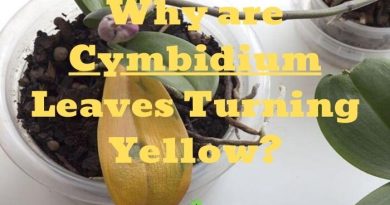Why are Holes in Peace Lily Leaves? [5 Reasons & How To Fix]
When it comes to caring for peace lilies , it seems simple and straightforward. You have to pay attention to certain things, such as the temperature and the amount of water it needs. But what if there are holes in peace lily leaves? What needs to be done? And what are the causes?
This article aims to answer why peace lily has holes in the leaves and what can be done about it.
The peace lily (Spathiphyllum spp.) is one of the most popular houseplants and with good reason and very few plants can claim to flower as easily and beautifully in typical home conditions as a peace lily.
Why There are Holes in Peace Lily Leaves
| Why There are Holes in Peace Lily Leaves |
|---|
| 1. Liriomyza Melanogaster (American serpentine leafminer) |
| 2. Black Vine Weevil |
| 3. Flea beetle |
| 4. Slugs and snails |
| 5. Caterpillars |
1. Holes in Peace Lily Leaves due to Liriomyza Melanogaster
Holes in the leaves of Peace Lily are an indoor flower lover worst nightmare, they can upset you, make you confused and desperate to help. The only reason holes start to appear on peace lily leaves is because liriomyza melanogaster is in the soil.
They are nothing but a race of insects commonly known as leaf miner flies. These flies dig tunnels through the leaves of the plant and cause damage to it. Getting rid of the pest will help prevent them from damaging the entire plant. Infected leaves, however, cannot be repaired.
Leaf miners are insects that damage Peace Lily leaves by digging tunnels through leaves, called mines and easily recognizable, inside and causing them to fall early and blocking the photosynthesis capabilities of attacked plant.
The insect is a small blackish yellow Diptera, while the larvae, which live inside the Peace Lily leaves, are yellow-orange.
Against these insects it is very important to intervene promptly and chemically , with larvicidal products which kill the larvae inside the mines.
Spraying with the natural insecticide neem (or neem), an agent obtained from the Indian neem tree (Azadirachta indica), also has an anti-feeding effect on the caterpillars of the leaf miner and damages them in their development
You can control leaf miners by spraying Peace Lily Leaves with:
- A treatment based on Bacillus thuringiensis;
- A rhubarb infusion;
- A concentrated solution of Neem oil.
- Spraying with nettle manure has also been shown to be effective against the leaf miner, but not in the case of an acute infestation.
2. Holes in Peace Lily Leaves due to Black Vine Weevil
Perhaps the best-known leaf-eating weevil is the black vine weevil ( Otiorhynchus sulcatus ), which eats the leaves of a wide range of plants, including Peace Lily Leaves.
The adult weevils feed on Peace Lily leaves, other parts of the plant and leave behind indented leaves, holes in leaves or eaten buds. Weevils spend the day either camouflaged on the ground or hiding under leaves and coarse plant material.
The vine weevils are nocturnal. The leaves are eaten, but this is not dangerous for the plant. However, the situation is different with their larvae, which become active in the root area of the plant. There they nibble off the fine roots, which are responsible for absorbing water, and later also the main roots.
Speaking of eating plants, do grasshoppers eat tomato plants? Find out here the answer!
You can control black vine weevil by:
- Collecting them in the dark using a flashlight
- Alternatively place flower pots under plants
- Fill the plant roots with wood wool
- Planting of strong smelling plants like marigold
- Spray with neem
- Use of entomopathogenic nematodes
Control the adults by applying diatomaceous earth (an organic insecticide) to the Peace Lily leaves.
3. Holes in Peace Lily Leaves due to Flea beetle
Generally very small, barely a few millimeters, they are nevertheless very voracious and do a lot of damage to the plants they devour. They feed on the leaves of certain plants including Peace Lily , making small round holes in them or nibbling only the surface. They mostly prefer young shoots, tender leaves.
First, it is tiny and also, very discreet, because it jumps like a flea and disappears from view when disturbed. If you quietly approach an infested plant, you may see one. It is a small, often metallic beetle and most common species are black.
They are black in color, sometimes with yellow stripes. They occur particularly in large numbers during long periods of drought.
In fact, there are thousands of species of flea beetles around the world and probably more than a dozen species in your own backyard. Most have a particular host plant, but some are more generalist.
Usually Flea beetle are recognized by their damage: leaves, especially younger ones, which are riddled with dozens of small depressions and round holes that evoke the riddle of a gunshot.
Control the Flea beetle by:
- Loosen the soil regularly
- Keep the plant well moist by spraying water on the leaves
- Darken the soil with a layer of mulch this keeps moisture in the ground
- Mixed culture with onions and garlic
- Place pieces of wormwood leaves around Peace Lily
4. Holes in Peace Lily Leaves due to Slugs and Snails
Slugs (in North America) and slugs and snails (in Europe) tend to attack from the middle of the leaf, less often the edge, leaving irregular open holes in Peace Lily with smooth edges. Often, in the morning, we find their business card: a trail of drool on the affected leaf.
Not only leaves are eaten, but there is sometimes a complete defoliation. The snail is particularly fond of tender Peace Lily leaves and flowers. It makes irregular holes along the Peace Lily leaves it eats.
Slugs are arguably every gardener’s worst enemy. Lettuce is particularly popular, but herbs, vegetables and flowers are not scorned either. Whole cultures can be destroyed overnight.
Measures must be taken as soon as slugs and snails appear:
- Collect regularly
- Set out bowls filled with beer
- Only water the root area of the plants and keep the soil finely crumbly and dry
- Laying out slug pellets or self-adhesive copper tape
- Place barriers of pine needles, nut shells or egg shells around Peace Lily beds
Slugs and snails need high humidity conditions and usually spend the day out of direct sunlight, hidden under rocks, pieces of wood, flower pots, etc. However, they are often active in broad daylight in gray and rainy weather.
They thrive under mulch at first, but ( laidback gardener stuff!), if you keep the mulch on, their enemies, protected by that same mulch, will increase in number and often eventually eliminate slugs and snails almost entirely.
To confirm the presence of slugs and snails, go outside at night and check the Peace Lily leaves with a flashlight.
5. Holes in Peace Lily Leaves due to Caterpillars
Another insect that can cause holes in the Peace Lily leaves are caterpillars. Some caterpillars only bore Peace Lily holes in the leaves, they penetrate inside the leaves.
Most species feed on leaves and young shoots, and their enormous foraging capacity can quickly decimate a plant.
Caterpillars are discovered by young or old leaves bearing irregular holes starting from the margin and abundant droppings on the Peace Lily leaves or on the ground. Sometimes whole leaves are swallowed up.
Caterpillars come in an unbelievable range of sizes, colors and even textures. On the other hand, many are well camouflaged, being the same color as their favorite host plants, and therefore difficult to find.
And they too have a wide range of hosts, from trees and shrubs to herbs, vegetables and flowers, well, pretty much anything that grows!
Some species dig in leaves or bore holes in fruit or stems, making them difficult to detect and combat. In addition to the feeding damage to the plant, caterpillars also contaminate the plant with their excrement.
Young foliage and shoot tips of various trees and other plants are very popular with them. The occurring caterpillars can be green, brown but also gray in color.
A severe infestation can lead to defoliation. Most of the damage is done by various butterfly larvae or sawfly larvae. Feeding damage to the edge of the leaf or very large holes in the leaf itself can occur.
Control the Caterpillars by:
- Remove them by hand
- Remove the eggs, by rubbing the underside of the Peace Lily leave
- White vinegar is generally effective
- Distribution of algae lime around the Peace Lily plant
- Green caterpillars hate beer, it seems
Bacillus thuringiensis kurstaki (BTK) is a biological insecticide specific to caterpillars and controls them well. Or try picking them by hand, dropping the culprits into a bucket of soapy water.
How To Prevent Holes in Peace Lily Leaves
Repeated treatments with insecticidal soap or neem oil may be necessary to eliminate them. The best way to avoid such problems is to keep any other infested plants away from your Peace Lily and inspect the plant thoroughly before purchase.
- Use a quality substrate. Poor soils are more prone to the appearance of pests.
- Take care of the soil substrate and prevent the appearance of weeds.
- Optimize care for the plant.
- Spray with infusion of neem oil.
- Remove diseased parts of the plant.
How To Keep the Peace Lily Healthy
Watering
Water the peace lily with distilled or rainwater to keep the soil moist. Water it in all seasons, 2 to 3 times a week in summer and once a week in winter. In case of hot weather, monitor the humidity of the soil (with your finger) and water accordingly.
For optimal growth, water your plant with cooled boiled water or tap water that has been standing for more than an hour.
Location
Place the peace lily plant in a warm location, away from direct sunlight. The plant needs indirect sunlight to grow as direct sunlight will burn the leaves.
The Peace Lily is a great plant for darker places in your home. In fact, the Peace Lily should be kept in dark places, as it does not do well in bright places. The ideal sunlight is low light to indirect sunlight.
However, they do need some light to thrive and won’t do as well in a dark room. They also won’t bloom if they don’t get enough light.
So put them in a place where they will receive intense, indirect sunlight. If your peace lily won’t bloom and you can’t give it more natural light, you can add grow light.
Cleaning and pruning
Clean the leaves weekly with a damp towel. This will remove dust and dirt from the foliage. Cut the flower stems back to the base of the plant when they begin to die back.
Here is how you trim cilantro to keep it fresh and growing!
Temperature and humidity
The peace lily likes warm temperatures at all times, above 55°F (13°C ) and up to 95°F (35°C). It also prefers good atmospheric humidity, but will tolerate dry air if necessary.
However, do not waste your time spraying water on the leaves to increase the ambient humidity, although this technique is often recommended, it is a waste of time. Instead, use a humidifier or humidifying tray to maintain adequate humidity if desired.
In winter, it does well between 58°F- 60°F (16 and 18°C). It will be able to withstand a minimum temperature of 55°F (13°C) but only for a short time.
In summer, it will be in good shape between 66 – 69°F (19 and 21°C) and will begin to suffer above 80°F (27°C). Maintain good humidity, especially in hot weather, by watering and misting it regularly.
The temperature, lily plants grow best in 18-22 degrees Celsius (64-71 F).
Fertilizing
During the main growth period, the peace lily gets a commercial fertilizer(water-soluble) for indoor plants according to the manufacturer’s instructions every third to fourth watering. During the winter you fertilize less often, between November and March one or two fertilizer applications are sufficient.
Peace lilies don’t need to be fed very often and should only be fertilized during the spring and summer months. Pay close attention to the type of houseplant fertilizer you use, as they are very sensitive to synthetic chemical fertilizers.
I recommend using compost fertilizer, which you can get in liquid form or buy compost tea bags and make your own.
You can also give your plant a foliar spray using tea compost, just put it in a spray bottle and spray the plant’s leaves.
Does your money tree leaves have holes in them? Here is the reasons and how to fix them!
Soil
To keep your Peace Lily happy, choose a soil with a pH value of 5.0 to 6.0 that will retain moisture for a few days to a week.
The Peace Lily doesn’t store much moisture in its stems, so it won’t do well if you have a soil that drains very well and doesn’t hold water for long. An ordinary houseplant mix or a palm mix is often an excellent choice.
Conclusion
The peace lily is a houseplant that does not require too much work, and with little effort it can be a perfect decoration for many years. When holes appear in the leaves then it means that a pest is responsible for these different types of damage.
In this article I have presented the most common causes why there are holes in Peace Lily leaves and also most important how to prevent their appearances.




